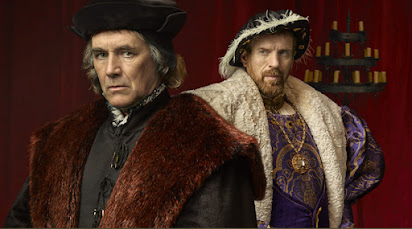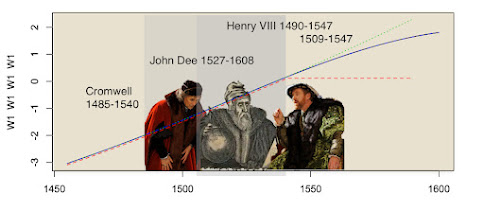I hope you are watching the final episodes of Wolf Hall Season 2 on PBS starting last Sunday, March 23, 2025 (the link is here and you might find parallels to the current political situation in the United States). In a prior post (here) I discussed Season 1. In this post, I will start laying some groundwork for Season 2. In future posts, I'll comment on the remaining episodes (you can stream Season2, Episode 3, Defiance or watch it over the air tonight).
To help me understand the The Tudor Period (1485-1603), I've constructed a number of state space models for England, France, Spain, Italy, Germany, Portugal, the World System and other countries in the World-System using available historical statistics (see the country models here that will be attached to future posts). The most noteworthy aspect of my WL16 state space World System model (here) are the two Growth Error Correcting Controllers (ECCs), one is an environmental controller (Q-T) and another is a Malthusian Population and Production controller (Q-N)--see the Measurement Matrix in the Notes below. I can also compare the WL16 model to a conventional economic growth model driven by technological change.*
Another important aspect of the Long Sixteenth Century was that it was the start of Capitalist Agriculture and the formation of the World-System (discussed here and here). The evolution of the World-System is my primary interest in the Wolf Hall TV series because it helps bring the history to life.
Historical re-interpretation is another way to bring history to life and Hillary Mantel does this in Wolf Hall (see the Real Story Behind Wolff Hall and the Fall of Cromwell from the Smithsonian Magazine).
I'm going to extend Hillary Mantel by including John Dee (a character not in "Wolf Hall"). ChatGPT (here) reports that Henry VIII "...did rely on astrologers like John Dee (who later advised Elizabeth I) and may have had private interactions with individuals claiming to predict the future." In the graphic above, I assume that sometime before Cromwell's execution, John Dee made two predictions, one (optimistic forecast) for Henry VIII and one (less optimistic) for Thomas Cromwell. The optimistic forecast was "unlimited growth forever" (the dotted green line in the graphic above) and the less optimistic forecast (the black-blue line) for a Limit to Growth (the dashed red line was the Random Walk--history is just one damed thing after another).
Notes
Links
- Thomas Cromwell (1485-1540) An English statesman and lawyer who served as chief minister to King Henry VIII from 1534 to 1540, when he was beheaded on orders of the king, who later blamed false charges for the execution.
- John Dee (1527-1608) an English mathematician, astronomer, teacher, astrologer, occultist, and alchemist.
- Catherine of Aragon The first wife of King Henry VIII from their marriage on 11 June 1509 until its annulment on 23 May 1533.
- King Henry VIII King of England from 22 April 1509 until his death in 1547.
- Elizabeth I (7 September 1533 – 24 March 1603) the only surviving child of Henry VIII and his second wife, Anne Boleyn. Queen of England and Ireland from 17 November 1558 until her death in 1603.
- English Reformation Took place in 16th-century England when the Church of England was forced by its monarchs and elites to break away from the authority of the Pope and the Catholic Church.
- Anne Boleyn Queen of England from 1533 to 1536 and the second wife of King Henry VIII.
- Oliver Cromwell (25 April 1599 – 3 September 1658) was an English statesman, politician, and soldier, widely regarded as one of the most important figures in British history.
- Thomas Wolsey An English statesman and Catholic cardinal. When Henry VIII became King of England in 1509, Wolsey became the king's almoner.
- Elizabeth Wyckes The wife of Thomas Cromwell (1485 – 28 July 1540), died in 1529 and his daughters, Anne and Grace, are believed to have died not long after their mother.
- Hans Holbein the Younger A German-Swiss painter and printmaker who worked in a Northern Renaissance style, and is considered one of the greatest portraitists of the 16th century.
- Wolf Hall A 2009 historical novel by English author Hilary Mantel, published by Fourth Estate, named after the Seymour family's seat of Wolfhall, or Wulfhall, in Wiltshire. Set in the period from 1500 to 1535, Wolf Hall is a sympathetic fictionalized biography documenting the rapid rise to power of Thomas Cromwell in the court of Henry VIII through to the death of Sir Thomas More.
- Wolf Hall (TV Series) a British television series adaptation of two of Hilary Mantel's novels, Wolf Hall and Bring Up the Bodies, a fictionalized biography documenting the life of Thomas Cromwell.
- World-Systems Theory A multidisciplinary approach to world history and social change which emphasizes the world-system (and not nation states) as the primary (but not exclusive) unit of social analysis.
- Sweating Sickness A mysterious and contagious disease that struck England and later continental Europe in a series of epidemics beginning in 1485.
- Holy Roman Empire A polity in Central and Western Europe, usually headed by the Holy Roman Emperor.[19] It developed in the Early Middle Ages and lasted for almost a thousand years until its dissolution in 1806 during the Napoleonic Wars.
- Timeline of British History 1500-1599
- Timelines of World History
- The Black Death The Black Death was a bubonic plague pandemic that occurred in Europe from 1346 to 1353. It was one of the most fatal pandemics in human history.
- English Civil War a series of civil wars and political machinations between Royalists and Parliamentarians in the Kingdom of England from 1642 to 1651.
- Peasant's Revolt a major uprising across large parts of England in 1381.
- Feudalism a combination of legal, economic, military, cultural, and political customs that flourished in medieval Europe from the 9th to 15th centuries.
- The 15th Century the century which spans the Julian calendar dates from 1 January 1401 (represented by the Roman numerals MCDI) to 31 December 1500 (MD).
- Little Ice Age a period of regional cooling, particularly pronounced in the North Atlantic region.
- Economic History of the United Kingdom the economic development in the British state from the absorption of Wales into the Kingdom of England after 1535 to the modern United Kingdom of Great Britain and Northern Ireland of the early 21st century.
- Tudor Period In England and Wales, the Tudor period occurred between 1485 and 1603, including the Elizabethan era during the reign of Elizabeth I (1558–1603).






No comments:
Post a Comment